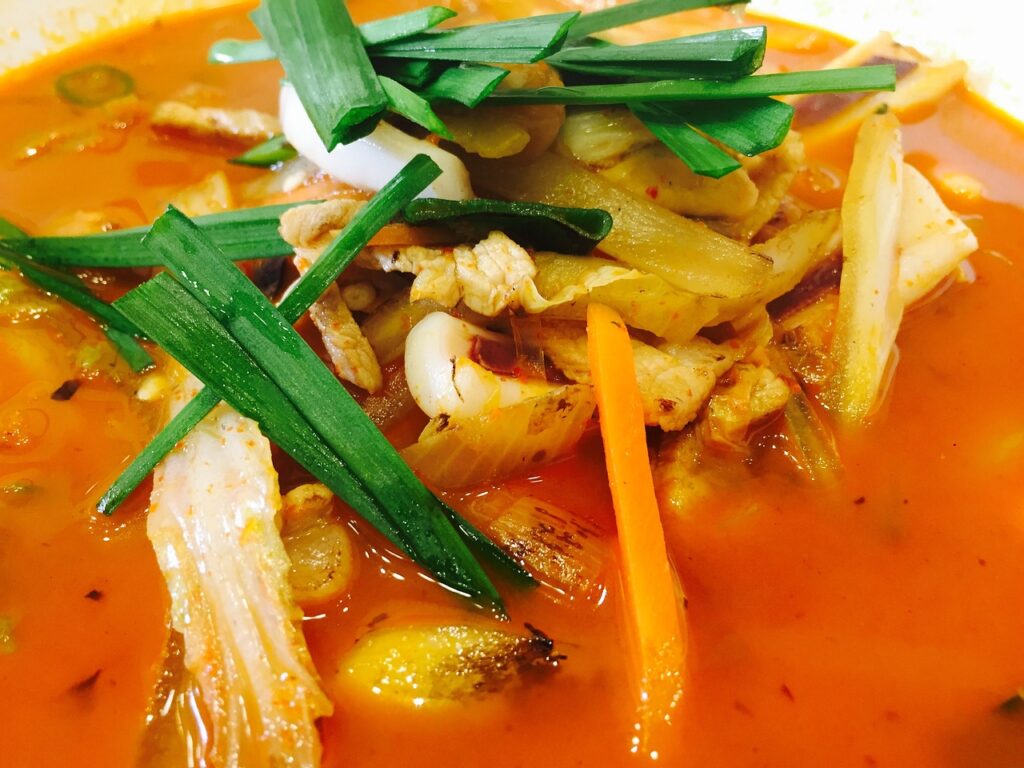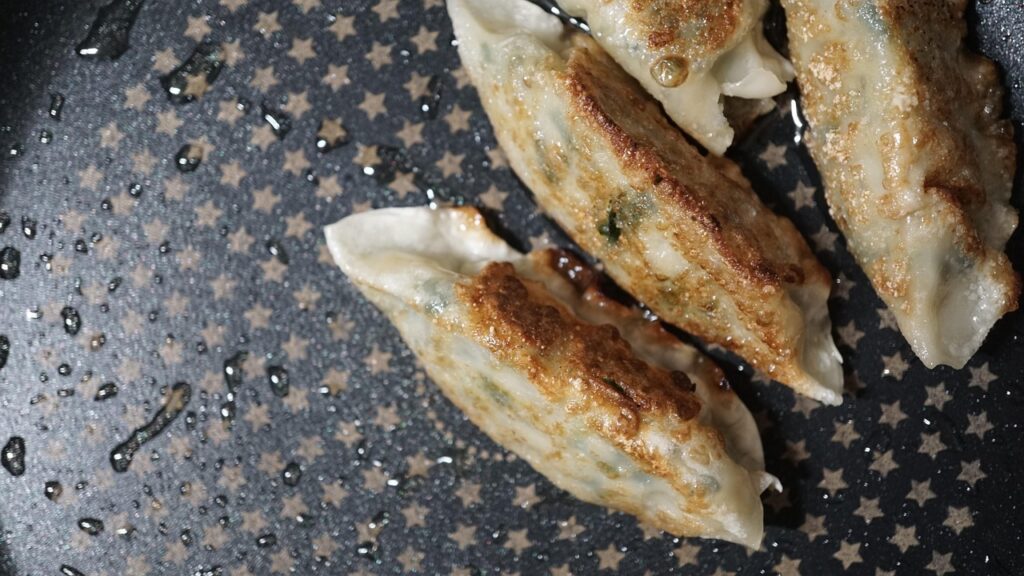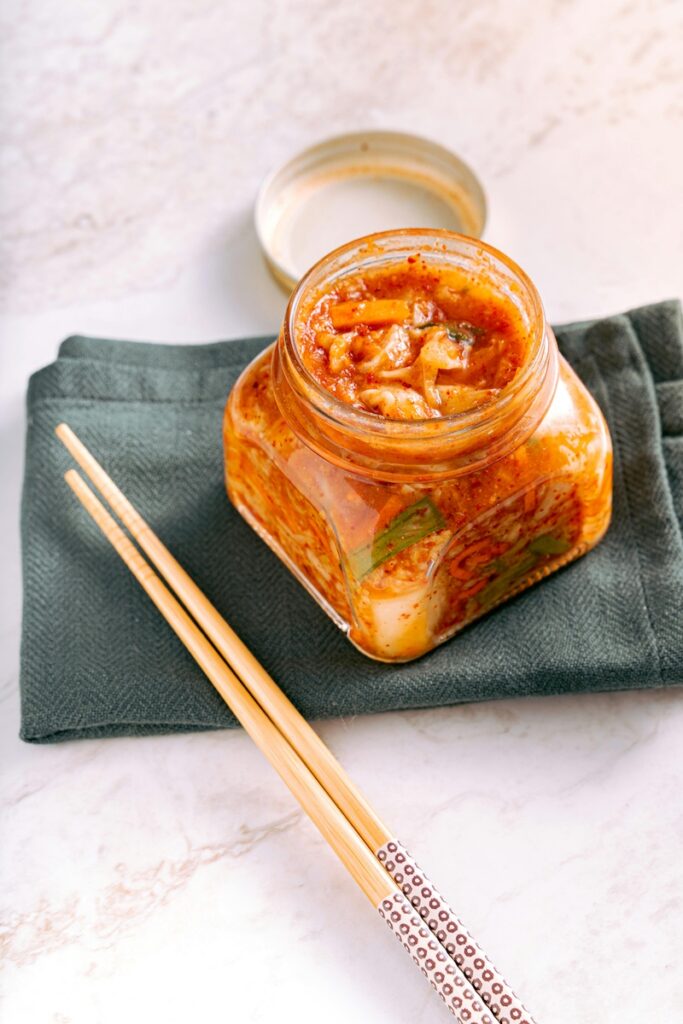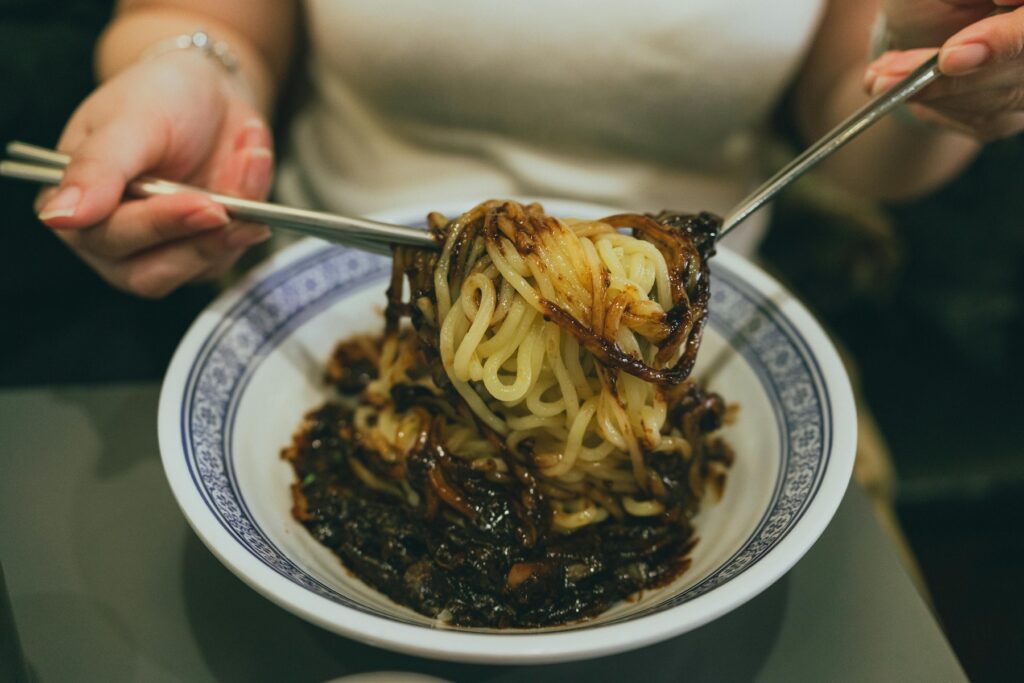“Why Koreans Eat Jjambbong When Stressed — The Fiery Noodle Soup You Must Try in Seoul”

🍜 Introduction: More Than Just Spicy Noodles
When foreigners first hear the word “jjambbong (짬뽕)”, they often think it’s just another spicy noodle dish.
But for Koreans, jjambbong is something deeper —
a comfort food, a hangover cure, and sometimes even a stress reliever in a steaming red bowl.
It’s one of those dishes that defines the Korean dining table:
you don’t just eat jjambbong — you feel it.
🌶️ 1. The Origin — Chinese Roots, Korean Soul
Jjambbong originally came from Chinese immigrants in Korea,
but it quickly evolved into something uniquely Korean.
While the name comes from the Chinese word “chǎomèng,”
the Korean jjambbong uses red chili powder, seafood, and smoky wok-fried vegetables
that give it a fiery, soulful flavor that can only be found in Korea.
Today, it’s a staple menu item at every Chinese-Korean restaurant,
sitting side by side with jajangmyeon (짜장면) — its eternal rival.
⚖️ 2. Jjambbong vs Jajangmyeon — Korea’s Ultimate Dilemma
Every Korean has faced this question at least once in their life:
“Should I order jjambbong or jajangmyeon?”
It’s a classic dilemma.
Jajangmyeon is sweet, thick, and comforting.
Jjambbong, on the other hand, is fiery, complex, and invigorating.
They are like two sides of the same coin —
and most restaurants even sell a half-and-half bowl (banban) for those who just can’t choose.
💬 Koreans often say:
“If you’re tired, go for jajangmyeon.
But if you’re stressed, jjambbong will fix your soul.”
🔥 3. The Taste of Fire — Why Koreans Love Spicy Broth
The secret behind jjambbong’s addictive power lies in its broth.
It starts with stir-fried onions, garlic, pork, and squid cooked over intense flame,
then mixed with rich chili oil and seafood stock.
That first sip hits you with a wave of heat and umami,
then lingers gently — like a warm hug from the inside.
For many Koreans, jjambbong isn’t just about flavor.
It’s about releasing stress, sweating out tension,
and finding comfort in the spice.
That’s why you’ll often hear:
“Had a bad day? Go eat jjambbong.”
🥢 4. Jjambbong as a Hangover Cure (and Drinking Companion)
In Korea, spicy soup means recovery.
Whether it’s after a night of soju or a long, stressful week,
jjambbong is one of the first things people crave.
The hot broth clears the head,
the chili wakes the body,
and the noodles give just enough comfort to start fresh again.
But jjambbong isn’t only for hangovers —
some Koreans even drink while eating it.
Soju with jjambbong might sound strange,
but locals know it’s the perfect balance of hot and cold:
a spicy mouthful followed by a clean, icy sip.
💬 As one Seoul office worker once said:
“After work, nothing beats a bowl of jjambbong and a shot of soju.
It burns away the stress better than any vacation.”
🍤 5. What’s Inside the Bowl — The Ingredients that Matter
A classic jjambbong includes:
- Squid, mussels, shrimp 🦑🦐
- Onion, cabbage, leek, carrot 🥬🥕
- Pork slices or seafood stock base
- Korean chili flakes (gochugaru) 🌶️
- Thick wheat noodles
The broth varies slightly by restaurant —
some are deep and seafood-heavy,
others are smoky and peppery.
Every version has its own fan club.

🍽️ 6. Local Tip — Don’t Forget the Fried Dumplings (Gunmandu)
Here’s the secret combo that locals love but tourists often miss:
jjambbong + gunmandu (fried dumplings).
The crunchy, golden dumplings balance the spicy broth perfectly —
dip them lightly into the soup before each bite,
and you’ll understand why Koreans can’t resist this pairing.
Some people even say:
“A jjambbong without gunmandu is like a concert without music.” 🎶
If you see a menu with “짬뽕세트 (Jjambbong Set),”
it usually means jjambbong + 3~5 fried dumplings + kimchi —
a combo that never fails.
🧣 7. Winter Comfort, All-Season Love
Jjambbong tastes great any time,
but in winter, it becomes magical.
There’s something deeply comforting about eating steaming noodles
while the cold wind blows outside.
Many Koreans describe it as “warming your soul.”
It’s not fancy — it’s familiar, nostalgic, and healing.
Even in summer, spicy jjambbong is popular,
because Koreans believe sweating out the heat helps cool the body afterward.
👕 8. A Practical Tip — Watch the Splatter!
If you’ve ever eaten jjambbong, you know — it’s dangerous for your clothes.
The red broth loves to jump off the noodles and land right on your shirt.
That’s why Korean restaurants usually offer aprons (앞치마, ap-chima).
Don’t hesitate to ask:
“Apron, please?” (in Korean: 앞치마 주세요 / ap-chima ju-se-yo)
Locals use them proudly — it’s part of the ritual!
🏙️ 9. Where to Try the Best Jjambbong in Seoul
Here are a few beloved spots locals swear by:
- Hongbanjang (홍반장) — spicy seafood jjambbong near Hongdae
- Paldo Jjamppong (팔도짬뽕) — deep, rich broth with pork
- Honglim Jjamppong (홍림짬뽕) — Gangnam favorite known for its heat
- Manrijang (만리장) — old-school Chinese-Korean restaurant in Myeongdong
You’ll find jjambbong almost everywhere —
from small mom-and-pop diners to 24-hour delivery spots.
❤️ 10. Why Jjambbong Feels So Korean
Jjambbong is more than just food —
it’s a reflection of Korean life itself.
It’s bold, emotional, sometimes overwhelming,
but always satisfying in the end.
When life feels heavy,
a bowl of jjambbong feels like hitting the “reset” button —
a spicy restart for both your stomach and your spirit.
“In every spoonful, you taste the heat, the sea, and the heart of Korea.”
🧭 Conclusion
If jajangmyeon is the soft melody of comfort,
jjambbong is the fiery rhythm of courage.
So next time you’re in Korea,
don’t just try jjambbong —
experience it.
Ask for an apron, order a few dumplings, and maybe even a shot of soju.
Take a sip of the spicy broth,
feel your heart race,
and you’ll understand why Koreans say:
“짬뽕 한 그릇이면 세상이 다시 보인다.”
“With one bowl of jjambbong, the world looks new again.”

